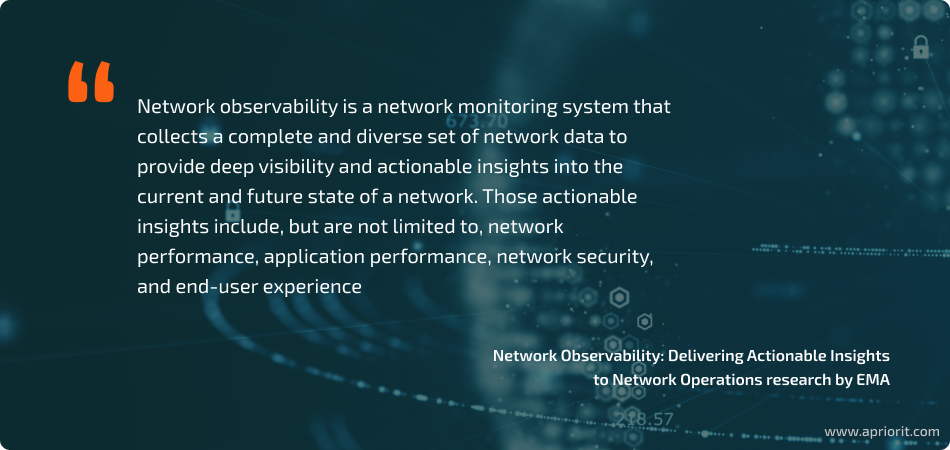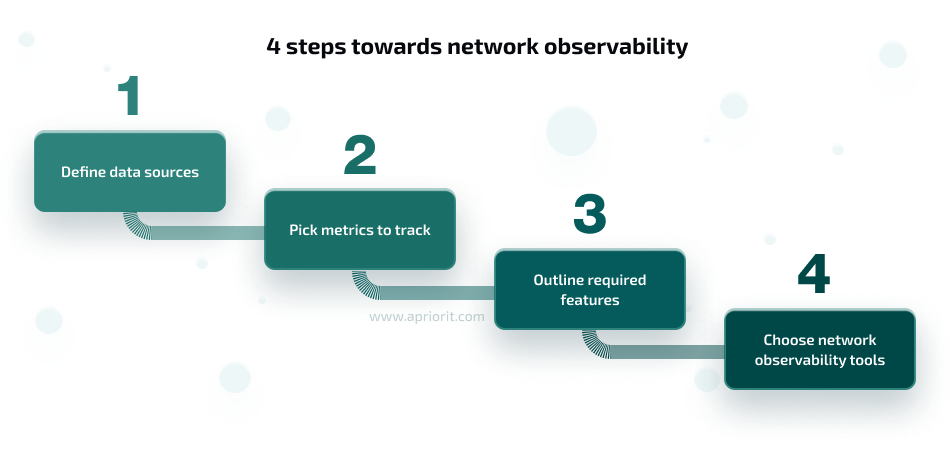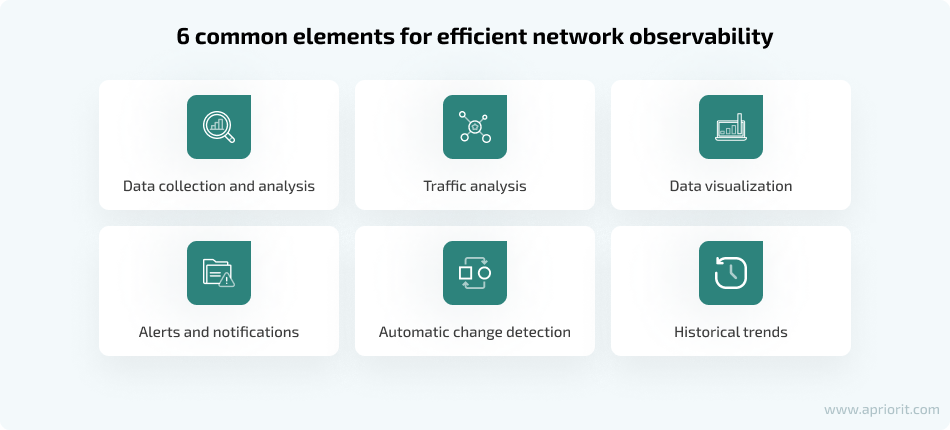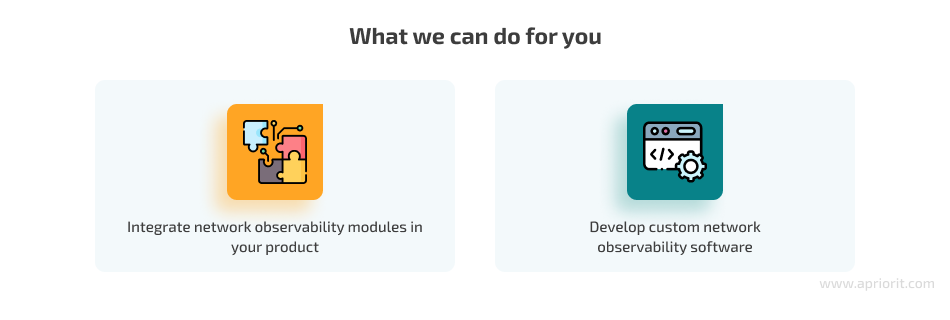Conventional monitoring approaches may no longer work for complex, ever-growing networks. Yet businesses have to keep an eye on the health of their networks to manage products with interconnected components, fight cybersecurity threats, improve network performance, and ensure a seamless user experience.
Ensuring network observability is a great way to gain a deeper understanding of the state of your networks. By adopting this approach, your team can get valuable insights into network performance, spot potential issues and anomalies early, and introduce improvements in a timely manner.
In this article, we discuss what network observability is, why you should implement it, and how to do so. You’ll also find five common use cases for this approach. This article will be useful for software product development leaders and network engineers looking for ways to improve their organization’s network observability and monitoring efforts.
What is network observability and why does it matter?
Network observability provides comprehensive insights into a network’s state, including its behavior, performance, and vulnerabilities. To achieve network observability, engineers combine network monitoring approaches and practices with tools for real-time visibility and a contextual understanding of network operations.

It’s tricky to define the main characteristics of network observability because this term is quite wide and open to interpretation. Also, the ways and reasons why engineers establish network observability vary depending on their goals and objectives.
However, we can outline the types of organizations that can benefit from network observability:
- Businesses who want to increase the efficiency of their enterprise solutions by optimizing their network infrastructure and network performance.
- Software vendors who offer products with many interconnected components and need to ensure proper network performance within their solutions.
- Organizations and software development companies that already use network monitoring practices but still can’t improve their network performance to the desired level.
With a thoughtfully planned and implemented network observability strategy, you can get a better understanding of a network’s impact on business objectives. You can also achieve various other benefits, including:
- Elevated network and data security
- Optimized network architecture
- Enhanced network performance
- Reduced downtime
- Better user experience
- Faster troubleshooting of issues
Want to maximize the capabilities of your networks?
With Apriorit’s assistance in network development, monitoring, and observability, you’ll meet all your project needs and business goals!
Network monitoring vs. network observability
The confusion between network observability and network monitoring is real even among experienced IT professionals.
A report on network observability by EMA mentions some engineers calling network observability a buzzword or another catchphrase for network monitoring. However, many industry specialists acknowledge observability practices broaden and deepen network monitoring, providing the ability to see what’s really going on at an application level and how the network is impacting that.
Note: Observability doesn’t eliminate the need for monitoring; monitoring is a technique used to achieve observability.
Let’s briefly compare the essential details of both terms to see the difference in these approaches.
| Network monitoring | Network observability | |
| Focus | Narrow: network device health | Wide: comprehensive view of network health |
| Collected data | Basic: uptime, bandwidth, device availability, etc. | Comprehensive: data from different sources like flows, packets, and telemetry |
| Alerts | Predefined rules | Predefined and machine learning-based anomaly detection |
| Data analysis | Manually launched and configured analysis of collected data | Automated real-time data analysis for immediate issue detection and troubleshooting |
| Objective | Provide basic visibility into the current state of a network | Gain deep insights and an understanding of network behavior, performance, and interaction |
On a side note, network observability can also be misinterpreted as DevOps observability. The difference is that DevOps observability is an approach that helps your team understand the state of applications running within distributed environments.
Now, let’s explore how to achieve network observability.
Related project
Developing a Custom ICAP Server for Traffic Filtering and Analysis
Explore how Apriorit engineers created a unique custom ICAP server with extended functionality that helped our client attract new customers and increase revenue.
How to establish network observability
Network engineers start by analyzing and defining the requirements and goals for an observability solution based on the information they want to get. Then, they create a network observability strategy, choosing the most relevant practices and tools. Network observability strategies can vary significantly in terms of their complexity and planned steps based on current network monitoring activities, infrastructure characteristics, the number of existing issues, etc.
However, we can outline the common steps most teams should take to start gaining more visibility into a network’s health:

1. Define data sources
Monitoring and analyzing the right data will help your team understand the internal state of the network based on external outputs. So, you need to carefully choose which data to focus on and define the sources of such data.
It’s crucial to start gaining insights into how different physical and virtual equipment operates. For example, a significant part of achieving network observability is capturing and analyzing packets. Network packets contain information about the sender, receiver, protocol used, size, time, etc.
Apart from capturing and analyzing packets, your team can observe the operations of:
- Routers, switches, and ports
- Servers, clients, and cloud services
- Containers and microservices
- Content delivery networks
- Access points
- Various endpoints, including IoT endpoints
2. Pick metrics to track
Network engineers should carefully choose which metrics to collect and analyze, keeping business goals and project specifics in mind. Different systems require observing different metrics. Let’s explore a few commonly tracked examples of metric categories:
- Performance: latency, jitter, bandwidth usage, network throughput, traffic volume, and distribution
- Reliability: uptime, downtime, mean time to repair
- Security: incident response time, threat detection time, number of security incidents
- Application performance: error rate, response time, transaction success rate
- Device: CPU use, interface errors, memory use
- User experience: network availability, end-user latency
3. Outline required features
List the goals you want to achieve with network observability and choose the features, components, and elements that will help you do that.
Apriorit network management specialists outline the following elements that should be helpful for the majority of projects:

- Data collection and analysis. Make sure to choose tools that can easily gather data from required sources and securely store it. Consider using solutions powered by machine learning (ML) to examine collected data for patterns, anomalies, and trends.
- Traffic analysis. A thoughtfully designed and implemented process of inspecting network traffic patterns can help your team identify network anomalies or suspicious user behavior. It can also assist with network performance optimization.
- Data visualization. An essential goal of network observability is gaining insights into your network’s health. Consider enabling tools or solutions that can visualize gathered data in formats that are easy to digest and work with, such as intuitive dashboards and reports.
- Automatic change detection. Being able to detect and track changes in real time can help your admins spot suspicious activity like unauthorized configuration changes. This can also help prevent human error, such as misconfiguration of critical devices, which might happen when tracking changes manually.
- Alerts and notifications. Enable features that notify your team about potential issues to significantly improve and accelerate problem resolution. Alerts and notifications will help your team respond in a timely manner to network issues, security threats, and performance issues.
- Historical trends. Add functionality that stores historical network data. This will facilitate trend analysis and capacity planning, enabling your team to learn from past incidents and know when to enhance network performance and reliability.
4. Choose network observability tools
To help your team gain insights into the state of the network, you need appropriate solutions, tools, or platforms. There are three common approaches to choose from:
- Combine and integrate a variety of third-party modules and configure infrastructure settings according to your project needs.
- Develop custom software for network observability tailored to your infrastructure requirements and needs.
- Use a commercial network observability platform, integrating it into your existing environments.
When choosing an option, consider your business goals, the project’s technical requirements, and your team’s expertise. For example, out-of-the-box solutions can be easy to install and start using right away, but they usually offer limited customization options. If you need some non-trivial features and rich customization options, consider developing custom software.
Network observability tools usually provide information to DevOps specialists, development leaders, site reliability engineers, and product owners. However, other development team members can also benefit from deploying them.
Once you choose the type of software that can help you observe your chosen data sources, collect required metrics, and leverage useful features, you can start your network observability activities, adjusting the process along the way. Make sure your engineers also establish an effective response plan as a part of your network observability strategy. By deploying appropriate and flexible workflows and integrations, your team can efficiently and timely remediate network performance problems detected during previous steps.
With network observability theory in mind, let’s move to the practical part and overview some real-life scenarios where this approach can benefit your network projects.
Read also
Secure and Anonymous Virtual Networking Infrastructure: How It Works, How to Implement It, and What’s Next
Find out how setting up a secure virtual private network can help you provide safe access to local and cloud resources. Enjoy a comprehensive overview of VPN technology and a step-by-step guide to enhancing network security with a VPN.

How you can leverage network observability: 5 use cases
Network observability provides your team with advanced knowledge of your network’s health. But what can you do with all these insights?
Tasks that businesses commonly try to accomplish with network observability include:
- Collecting tons of telemetry data from different sources within the network: servers, applications, routers, firewalls, etc.
- Automating the analysis, correlation, and visualization of collected data to help engineers understand how networks are functioning
- Letting administrators easily observe and analyze network traffic flows by monitoring relevant metrics
- Helping development teams quickly check the state of networks at any given time, better protect resources, more quickly detect and solve performance issues, and mitigate risks
- Assessing network performance with regard to business goals and make forecasts
Let’s also explore a few common use cases for establishing network observability.

1. Troubleshooting network issues. Device hardware, network configurations, firmware, and many other things could cause network issues. Unfortunately, regularly assessing each potential source of issues manually is almost impossible. To properly detect and troubleshoot issues, your admins can visualize network topology and monitor traffic flows with network observability tools. This will allow them to instantly detect issues, pinpoint where they occurred, and start solving them right away. As a result, you can reduce downtime, minimize service disruptions, and enhance your overall network performance.
2. Automatically generating reports. Putting tons of data together is always challenging — and all the more so if you need to present information about networks within a complex environment or software with many interconnected components. By integrating third-party tools into your network observability infrastructure or developing a custom reporting module, your team can significantly simplify and accelerate reporting. For instance, you can automatically create daily reports informing the team about what changed in the past 24 hours or the last week. Or you can have your tools showcase information about previous malfunctions to help your team assess network health and even predict future issues.
3. Handling security threats. ML-based network observability solutions allow your team to detect subtle anomalies that conventional cybersecurity measures can miss. After being notified of those anomalies, your admins can quickly check whether there is danger and immediately start mitigating it if necessary. Network observability efforts can even help administrators detect early stages of a DDoS attack. Also, if your team ensures the integration of network observability solutions with security systems, you will be able to leverage automated responses to some threats. For example, your tools can automatically isolate a compromised device or block malicious IP addresses.
4. Assessing network architecture. When monitoring metrics that reflect latency, traffic patterns, and performance, your team might spot gaps in network operability, reliability, security, and scalability. This knowledge can help administrators identify issues in the network architecture itself and start fixing them before they lead to severe consequences like errors, outages, and severe decreases in network performance. For example, your network team can implement load balancing, enhance redundancy, patch vulnerabilities, and plan for future capacity needs.
5. Conducting root cause analysis. When analyzing data collected from various network components and monitoring tools, your team can not only spot unusual spikes or anomalies but also analyze the reasons behind them. In some cases, such analysis can even help your engineers identify the underlying causes of network performance issues like outages, slowdowns, and security breaches. Then, your admins can use the knowledge gained to efficiently debug the software as well as to prevent network bottlenecks, latency issues, and bandwidth constraints. In case of an attack, comprehensive logging of network activities allows for in-depth analysis of security incidents, helping to identify the source and method of an attack.
Related project
USB Wi-Fi Driver Development
Explore our insights into developing a Windows-based network security analysis solution for our client. Discover how the delivered driver enhanced our client’s product and benefited their business.
How Apriorit can help you achieve network observability
According to the EMA report, IT engineers and program managers often complain about difficulties with:
- Deploying and configuring network observability tools
- Receiving unnecessary alerts
- Having fewer insights than expected
- Receiving poor customer support from network observability providers
Not to mention the cost of infrastructure which maintains the platform. The more metrics you have to observe, the more resources you need.
To gain only valuable insights into your network’s health, establish convenient work with observability tools, and receive a cost-efficient solution, entrust your network observability efforts to true specialists.
At Apriorit, we have rich experience assisting our clients with establishing efficient network monitoring and observability for their software products, environments, and organizations.

Here’s what we can do to make sure our clients have great visibility over their network health:
1. Integrate network observability modules into your product. Apriorit’s network engineers will choose tools and modules that ensure the required level of network observability, tailored to your needs. Once we receive a request from you, our experts will carefully analyze your requirements. Based on that analysis, we’ll choose the most relevant third-party components, tools, solutions, and programs — and start integrating them into your product. Additionally, we can develop custom modules if needed.
2. Develop custom network observability software. Upon your request, a dedicated Apriorit team can also build a new customized program from scratch, creating scripts that efficiently and securely gather required metrics. From software planning to development and delivery, we make sure your software provides all the functionality you require for efficient network monitoring and observability. In this case, Apriorit developers can also integrate third-party tools after agreeing on it with your team.
When using third-party components, we always pick proven and secure databases (like Mimir or Loki, PostgreSQL, MySQL), infrastructure (like AWS, Microsoft Azure, Google Cloud), dashboards (like Grafana, Kibana, Splunk), and more.
Apriorit specialists can also assist you with network observability automation to improve troubleshooting, root cause analysis, problem isolation, and anomaly detection, saving your team’s time.
Conclusion
Bringing your network monitoring to the next level and achieving network observability can be challenging. Your team has to review current strategies, carefully pick new approaches and tools, and wisely choose which metrics to collect.
However, with a thoughtful approach to network observability, you can get a comprehensive picture of your networks and know exactly what to optimize, fix, and improve.
At Apriorit, we have experienced network development and management teams ready to assist you with tasks of any complexity, from developing your networks to establishing thorough observability across them.
Ready to level up your network game?
Achieve desired network performance that supports your business goals. Entrust your network development, management, and monitoring efforts to Apriorit’s experienced engineers.




